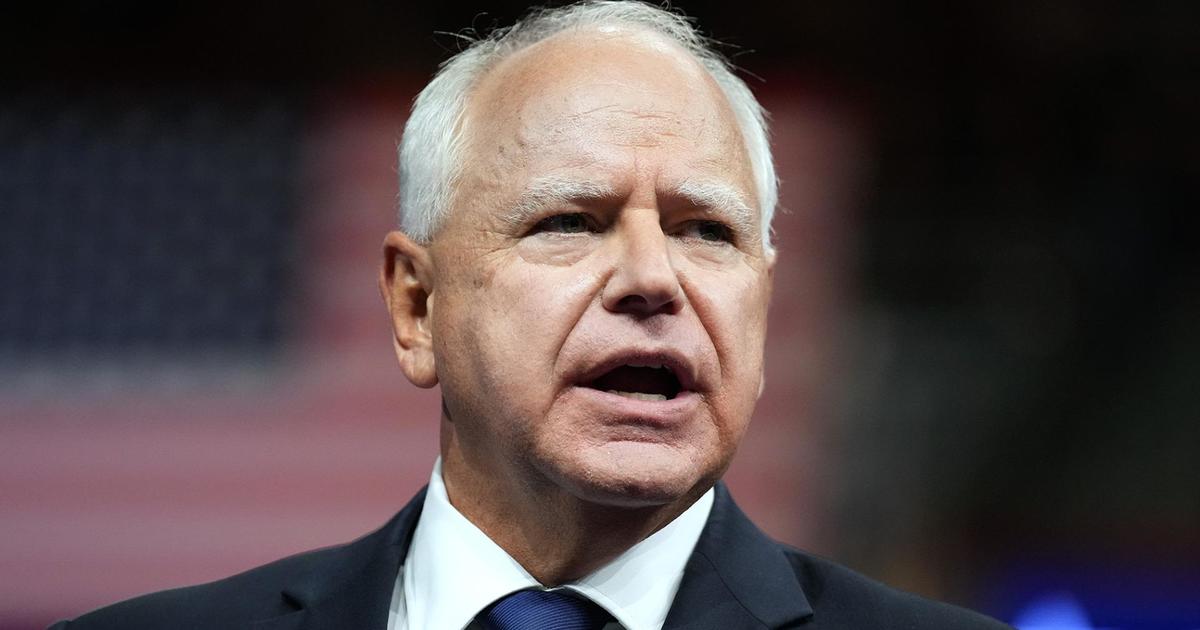As governor of Minnesota, one of Tim Walz’s accomplishments was signing a 2023 education law that included a mandate for schools to provide free menstrual supplies to students in grades 4 through 12.
That mandate is drawing fresh attention as the Trump campaign seeks to criticize Walz for the law, claiming it requires school districts to supply tampons and pads to both female and male bathrooms due to transgender boys who may menstruate. On social media, the hashtag #TamponTim began trending on August 6, the day Walz was named as Vice President Kamala Harris’ running mate for the Democratic presidential ticket.
As a woman there is no greater threat to a woman’s health than leaders … who support putting tampons in men’s bathrooms in public schools,” Trump campaign spokeswoman Karoline Leavitt told Fox News on Tuesday.
In a statement emailed to CBS MoneyWatch, Leavitt claimed that Walz “has spent his governorship trying to reshape Minnesota in the image of the Golden State.” She added, “Tampon Tim put tampons in boys’ bathrooms, wants men to play in women’s sports, and supports gender transitions for minors.”
The Minnesota law, however, doesn’t specify in which bathrooms the menstrual supplies must be located; instead, it requires school districts to develop plans to ensure all students who menstruate can access free tampons and pads, Lacey Gero, director of government relations at the advocacy group Alliance for Period Supplies, told CBS MoneyWatch. Her group advocates for free tampons and pads in schools, prisons and other institutions and eliminating the so-called tampon tax.
Struggling with “period poverty”
While it’s unclear how many transgender children could benefit from free menstrual supplies, the impact is mostly felt by the millions of girls who experience so-called “period poverty,” or the inability to afford pads and tampons. About one in four teenagers who menstruate struggle to pay for period products, according to a 2023 study from the advocacy group Period.
“We’re hearing from somebody who was a teacher, that [Walz] recognized that students need school-supplied period products, and this issue is something we hear about from students across the country today,” Gero said. “My hope is that this being in the public eye brings attention to an issue that many people might not know about or may have never thought about.”
When Walz, who worked as a high school social studies teacher for two decades, signed the education bill last year, he said, [W]e’re saying today ‘We’re leaving no one behind’,” according to the Minnesota Reformer.
The bill, which boosted education funding in the state by $2.3 billion, included many other measures, such as new funding for early childhood education and adding civics and personal finance courses in high schools.
The Harris-Walz campaign didn’t immediately respond to a request for comment.
The cost of menstrual supplies
Criticizing Walz for providing free period supplies underscores the stigma still attached to menstruation, Gero said. Girls and women who struggle to afford menstrual products often feel greater levels of stress and shame, which can impact their performance at school or at work.
One 2019 study of low-income women in St. Louis, Missouri, found that two-thirds weren’t able to afford pads or tampons in the prior year, with many resorting instead to rags, tissues or paper towels. About half said they couldn’t afford to buy both food and menstrual products.
People who can’t afford pads or tampons “have reported missing school or work because they don’t have these supplies,” Gero said. “It leads to missed opportunities, and it is linked to feelings of embarrassment and depression.”
Minnesota is one of 28 states that currently require schools to provide period products, although not all of them supply funding for schools to purchase pads or tampons. A similar measure recently failed in Florida, when Governor Ron DeSantis in June vetoed funding that would have provided free menstrual supplies to students.
Meanwhile, the cost of pads and tampons is rising faster than the rate of inflation, adding to the financial burdens facing women and girls who require these supplies. Since 2019, the typical price for a box of tampons has increased 36%, reaching $8.29, while a pack of pads has soared 41% in the same period, the Wall Street Journal reported last month.
By comparison, the consumer price index, a broad measure of inflation, has increased 21% over the same period.
“Cost is definitely an issue,” Gero noted. “And because there are still states that are taxing period products, it puts an unfair burden on people who menstruate.”
Meanwhile, the criticism from Trump’s campaign over Minnesota schools’ free menstrual products is receiving pushback from a number of critics on social media, with some noting that providing free pads and tampons to students could help many perform better in school.
“Tim Walz passed a law requiring free sanitary products to be available in all schools for kids. What a monster! How dare we make sure our kids are taken care of!” wrote cardiologist Dr. Siyab Panhwar on X.

